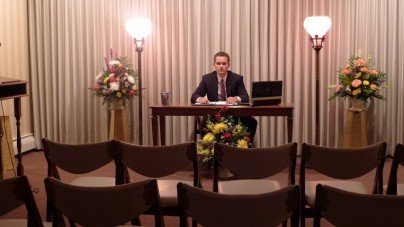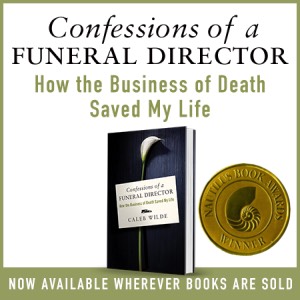Archive for year 2014
Writing the Dark Chapters
I walk into a room at 6 a.m. and all eyes fix on me and my next move. I am, after all, the odd one out in the room, the one whose face isn’t stained with tears; the one wearing dress clothes, who’s there in body, but whose soul isn’t in the depths.
I’m the colonialist, walking into another culture, ready to impose society’s desire for a clean picture of death.
Those who are sitting around the bed of the deceased aren’t thinking about what you and I are thinking about at 6 in the morning. They aren’t wondering how they will get their kids dressed in time for school; or how they’re going to pitch their project to coworkers at work.
Everything is on hold.
Time has slowed at a pedestrian pace and they sit in grief … resisting the reality that what was their husband, their wife, their son, daughter, grandfather, friend is no longer present to hug, laugh and live with.
Death creates its own culture … its own world.
A world where time seems to altogether stop, where language is often spoken with less words and more tears, hugs and contemplation, where the regular dress code doesn’t exist and where the norms and mores of society are put on hold. Here, in this sacred space at 6 a.m. in the morning, God seems nearer; family and friends surround you; you can let your emotional inhibitions go. This is the world that was never meant to be and yet is everything you wish it could be. It seems we have to go back through death to get to Eden.
With tie draped down my dress shirt, if I can’t imagine a world unlike mine … if I can’t picture a context outside of me … if I can’t remove myself from the all too obvious facts that it’s 6 a.m., I’m tired, didn’t get my Dunkin Donuts medium coffee with cream and sugar, and that I’ll be even more tired tonight when I’m supposed to go to Chili’s with my wife; if I can’t imagine the family’s story; the story of the deceased and his life and the loss this represents, I can’t be a good funeral director.
Funeral directing is a lot like writing. It involves alterity, imagination and the ability to make a lot of the detail and little of the obvious. I write the story as I walk into the sacred space of grief.
I notice the one closest to the decease’s body. ”That’s probably the NOK”, I think to myself. Granted, the story is easier to imagine if I already know the family, but this morning I don’t. The closest one to the bed is oft the main character in this play; and I can write a story of comfort, by entering the narrative with a warm hug, maybe even a kiss, a kind smile and eyes that speak of the compassion my heart is feeling; or, I could write a story as a narrator, standing back, observing and not entering. What does this specific family need?
I wait as the drama unfolds, as my very presence evokes the supporting characters who will inevitably point me to the protagonist.
Asking questions; feeling out the room. I enter in and I – at this very moment – have the privilege and responsibility of helping to write this chapter.
11 Photos of the Cemetery at Mt. Everest
There have been over 200 climbers who have died in the area of Mt. Everest known as “The Death Zone” (the area above 26,000 feet). Because of the harsh conditions and lack of oxygen, most of these bodies remain on Mt. Everest in the same position in which they died. Most of the bodies have been mummified by the sub-freezing climate.
Below are 11 photos of this Mt. Everest Cemetery. Some of the images are graphic.
1.
The body of David Sharp still sits in a cave, known as “Green Boots Cave”, at the top of Mount Everest. David attempted the climb in 2005 and near the top, stopped in this cave to rest. His body eventually froze in place rendering him unable to move. Over 30 climbers passed by him as he sat freezing to death. Some heard faint moans and realized he was still alive. They stopped and spoke with him. He was able to identify himself but was unable to move. Brave climbers moved him into the Sun in an attempt to thaw him but eventually, realizing David would be unable to move, were forced to leave him to die. His body still sits in the cave and is used as a guide point for other climbers nearing the summit.
2
Bodies of those who died at Advanced Base Camp are also left lying where they succumbed to the cold.
3
George Mallory died in 1924 and was the first to make an attempt to reach the summit of the world’s highest mountain. His body, still perfectly preserved, was identified in 1999.
4
Climbers often stack rocks and packed snow around the bodies in an effort to protect them from the elements. Nobody knows why this body skeletonized.
5
Bodies lie on the mountain frozen in the position they were in when the person died. Here a man had fallen off the trail and too tired to rise, died where he fell.
6.
It is assumed that this person died while resting against a snow bank which has since evaporated leaving the body in this odd raised position.
7
Some die from falls leaving their bodies in a location where they can be seen but not recovered. Bodies that are located on small ledges are often rolled off to hide them from view of other climbers only to be buried by falling snow.
8
Wind and environment sometimes leaves clothing in tatters as seen in this “collection” of bodies lying at the bottom of a dangerous cliff.
9
Sun and wind have dried this body leaving a “mummified” corpse.
10
The body of “Green Boots” (an Indian climber who died in 1996) lies near a cave that all climbers pass on their way to the peak. Green Boots now serves as a waypoint marker that climbers use to gauge how near they are to the summit. Green Boots became separated from his party in 1996 and sought this mountain overhang (really a small, open mouthed cave) to use as protection from the elements. He sat there shivering in the cold until he died. The wind has since blown his body over.
11
Francys Arseniev, an American women who fell while descending with a group (that included her husband), pleaded with passerby’s to save her. While climbing down the side of a steep section of the mountain, her husband noticed she was missing. Knowing that he did not have enough oxygen to reach her and return to base camp, he chose to turn back to find his wife anyway. He fell to his death in the attempt to climb down and reach his dying wife. Two other climbers did successfully reach her but knew carrying her off of Mount Everest was not an option. They comforted her for a while before leaving her to die. Feeling great remorse, they returned eight years later vowing to find the body and enshrine it in an American flag (they succeeded). After details of the disastrous climb became known, it was realized that Francys Arseniev had become the first woman from the United States to reach the summit of Mount Everest without the aid of bottled oxygen.
The photos and captions were sourced from IMGUR.
Wikipedia has compiled a list of people who have died climbing Mt. Everest. You can view that list HERE.
Stupid Gold Digger Joke
When Bob found out he was going to inherit a fortune after his sickly father died, he decided he needed a woman to enjoy it with. So one evening he went to a singles’ bar where he spotted the most beautiful woman he had ever seen.
Her natural beauty took his breath away. “I may look like just an ordinary guy,” he said as he walked up to her, “but in just a week or two my father will die, and I’ll inherit twenty million dollars.”
Impressed, the woman went home with him that evening. Three days later, she became his stepmother.
From the book, “Heidegger and a Hippo Walk Through Those Pearly Gates”.














